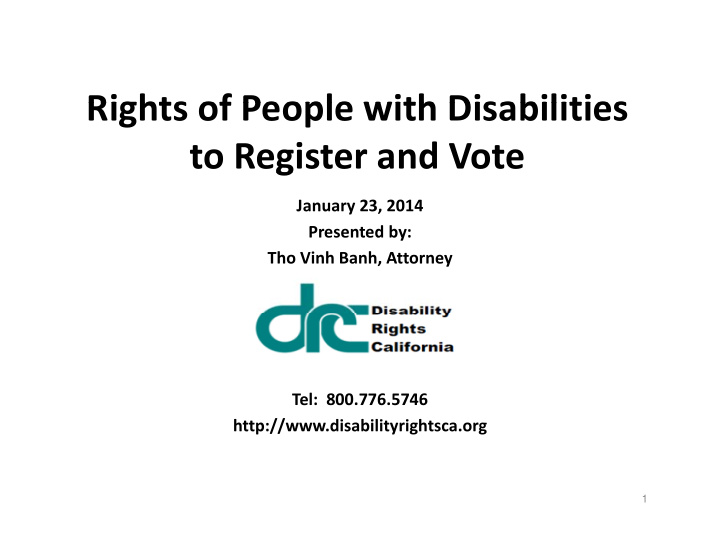



Rights of People with Disabilities Rights of People with Disabilities to Register and Vote g January 23, 2014 Presented by: Tho Vinh Banh, Attorney Tel: 800.776.5746 http://www.disabilityrightsca.org 1
R Registrants with Disabilities i t t ith Di biliti (US Census Bureau, Current Population Survey, Nov. 2012) Reported Registered: 19 million people with Reported Registered: 19 million people with disabilities Registration rate: People w/disabilities R i i P l /di bili i registered at 69.2% vs. 71.5% w/o disabilities (2 3% (2.3% points lower) i l ) 2
Registrants with Disabilities Registrants with Disabilities (US Census Bureau, Current Population Survey, Nov. 2012) Registration Rates Lower for Certain Groups : ‐ Cognitive difficulty: 59.3% ( ‐ 12.2%) ‐ Ambulatory difficulty: 69.5% ( ‐ 2%) bu ato y d cu ty 69 5% ( %) ‐ Self ‐ care difficulty: 62.1% ( ‐ 9.4%) 3
Registrants with Disabilities Registrants with Disabilities (Disability, Voter Turnout, and Voting Difficulties in the 2012 Elections. Lisa Schur, Meera Adya, Douglas Kruse http://smlr.rutgers.edu/research ‐ centers/disability and voter turnout) centers/disability ‐ and ‐ voter ‐ turnout) How Individuals w/Disabilities Registered to V t Vote: Town hall/county/gov. registration office: 31.5% DMV: 21.9% By mail: 15.8% Public assistance agency: 2.7% 4
Registrants with Disabilities Registrants with Disabilities (Disability, Voter Turnout, and Voting Difficulties in the 2012 Elections. Lisa Schur, Meera Adya, Douglas Kruse http://smlr.rutgers.edu/research ‐ centers/disability and voter turnout) centers/disability ‐ and ‐ voter ‐ turnout) Why Individuals Did Not Register: Most common reason for not registering to vote: lack of interest in the election or politics: (disability: 32.1%; no disability: 45.2%) Specific reasons for not registering to vote: Permanent illness or disability: (disability: 24.5%; no disability: 1.2%) 5
Registrants with Disabilities Registrants with Disabilities VRAs are required to: ‐ Provide a Voter Registration Card (VRC) and Voter Preference Form ‐ Assist with filling them out when requested ‐ Provide the same level of assistance completing the VRC as in completing the agency’s own form ‐ Provide assistance in the person’s home if agency provides services in the person’s home id i i h ’ h 6
Registrants with Disabilities Registrants with Disabilities Common Misconceptions Why People with Common Misconceptions Why People with Disabilities Cannot Register or Vote: – If the person has a disability: physical, psychiatric, If the person has a disability: physical, psychiatric, intellectual disability, developmental disability, etc. – If the person is not able to read – If the person is not able to write – If the person uses a wheelchair (access concerns) p ( ) – If the person is under conservatorship 7
Registrants with Disabilities g ( California Elections Code Sec. 2208) Who Decides? Who Decides? Only a court can decide: Any person who has not been Only a court can decide: Any person who has not been judged by a court “not capable of completing an affidavit of voter registration.” Don’t make assumptions about a person’s ability to register and to vote based on the person’s disability. 8
Registrants with Disabilities Assistance to Applicants pp Voter Registration Agency Employees: ‐ Do not make statements or take actions that give Do not make statements or take actions that give the impression that registering to vote has bearing on whether they get services bearing on whether they get services ‐ Do not take any action with the purpose or effect of discouraging voter registration of discouraging voter registration ‐ Do not seek to influence political party preference or party registration or party registration 9
Disability Etiquette Disability Etiquette Basic Guidelines Basic Guidelines – Make references to the person first then the disability: Say “a person with a disability” rather disability: Say a person with a disability rather than “a disabled person.” – Do not use the term “handicapped” when pp referring to a person with a disability. – Offer assistance, but wait until your offer is accepted before you help. – Listen to any instructions the person may give. 10
Disability Etiquette y q Common Courtesies – Share the same social courtesies. If you shake hands with people you meet, offer your hand to everyone you meet, regardless of their disabilities. – When offering assistance to a person with a visual impairment, allow that person to take your arm. Guide, rather than propel or lead the person. Use specific directions when directing a person with a specific directions when directing a person with a visual impairment. 11
Disability Etiquette Disability Etiquette Conversation – Speak directly to the person with a disability, not to the person accompanying them. The same principle applies for people who communicate through sign language. th h i l – When greeting a person with a severe loss of h h l f vision, always identify yourself and others. For example say “On my right is John Smith ” example say, On my right is John Smith. 12
Disability Etiquette Disability Etiquette Conversation (cont’d) – Speak in a normal tone of voice and indicate when the conversation is over. Let them know when you move from one place to another. For more information on disability etiquette: http://www.unitedspinal.org/pdf/DisabilityEtiquette.pdf For more information about voting rights of individuals with For more information about voting rights of individuals with disabilities: http://www.disabilityrightsca.org/pubs/PublicationsVoting.htm p y g g p g 13

Recommend
More recommend